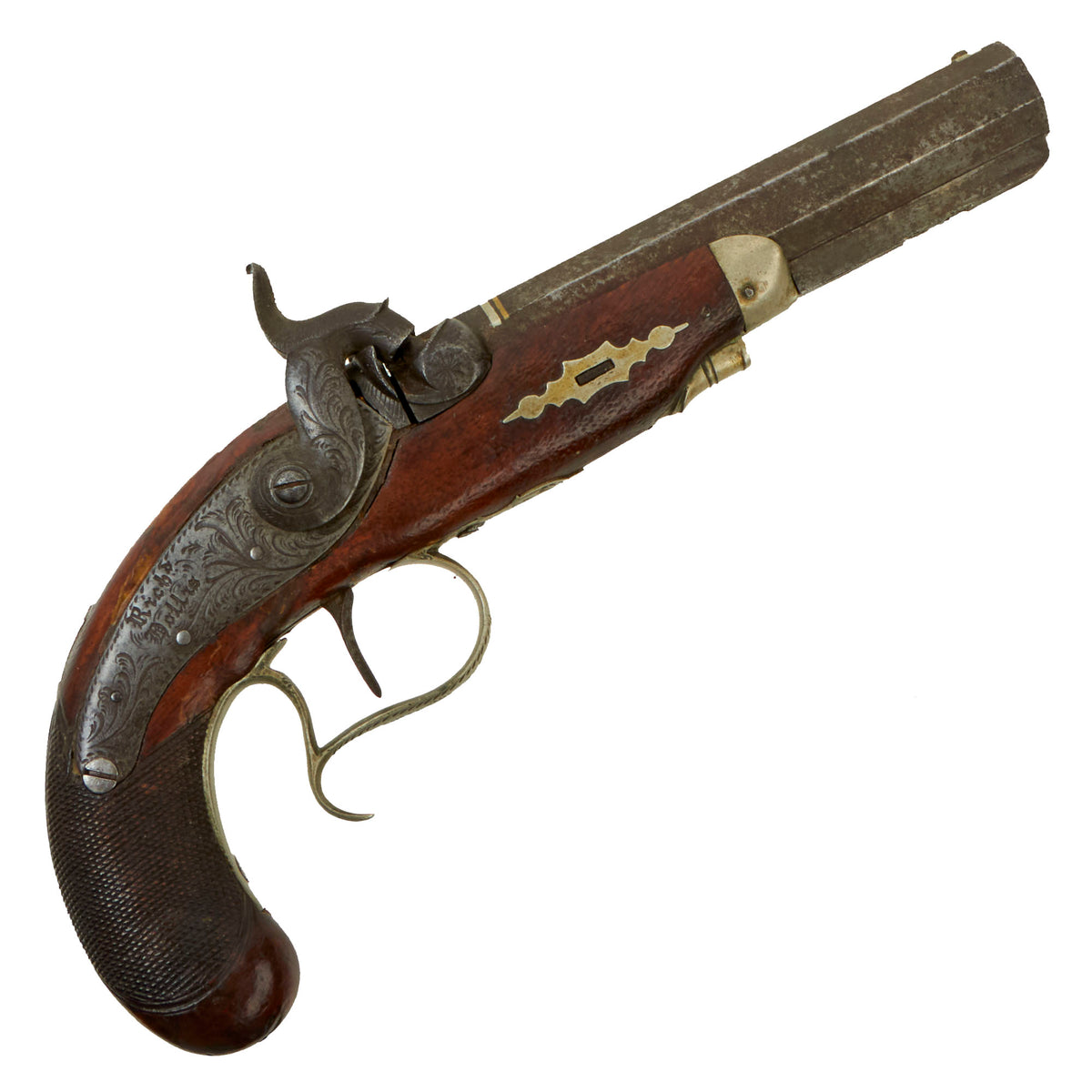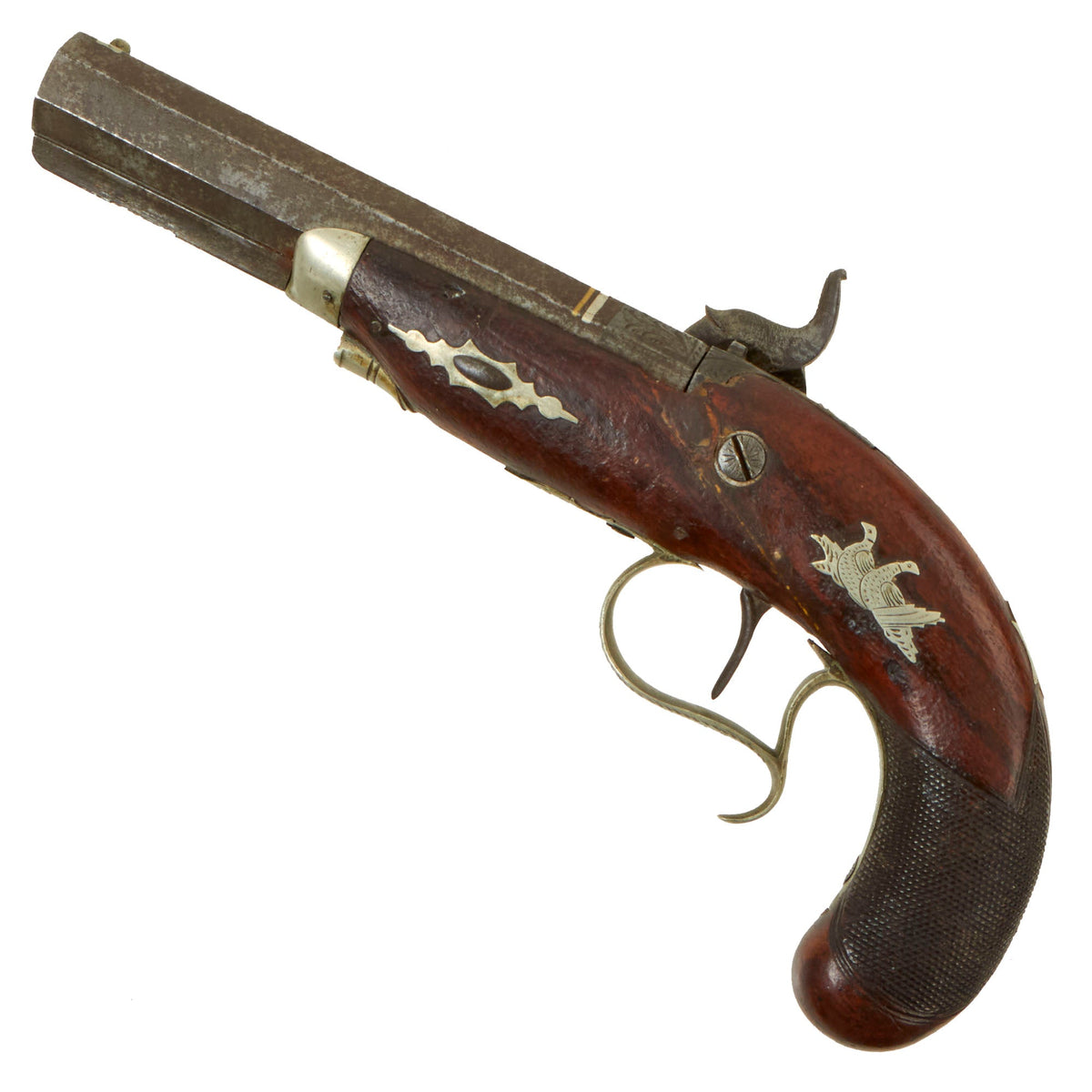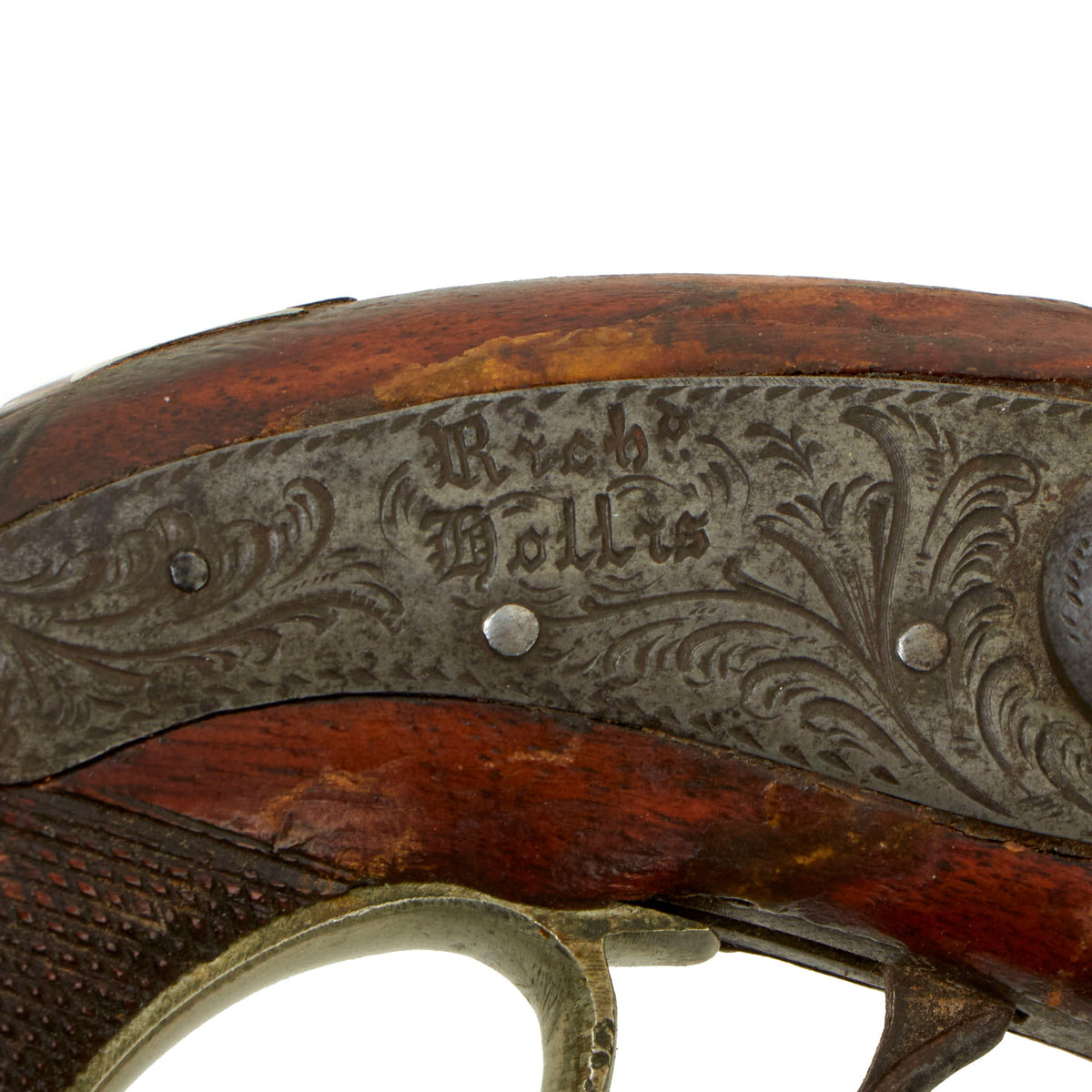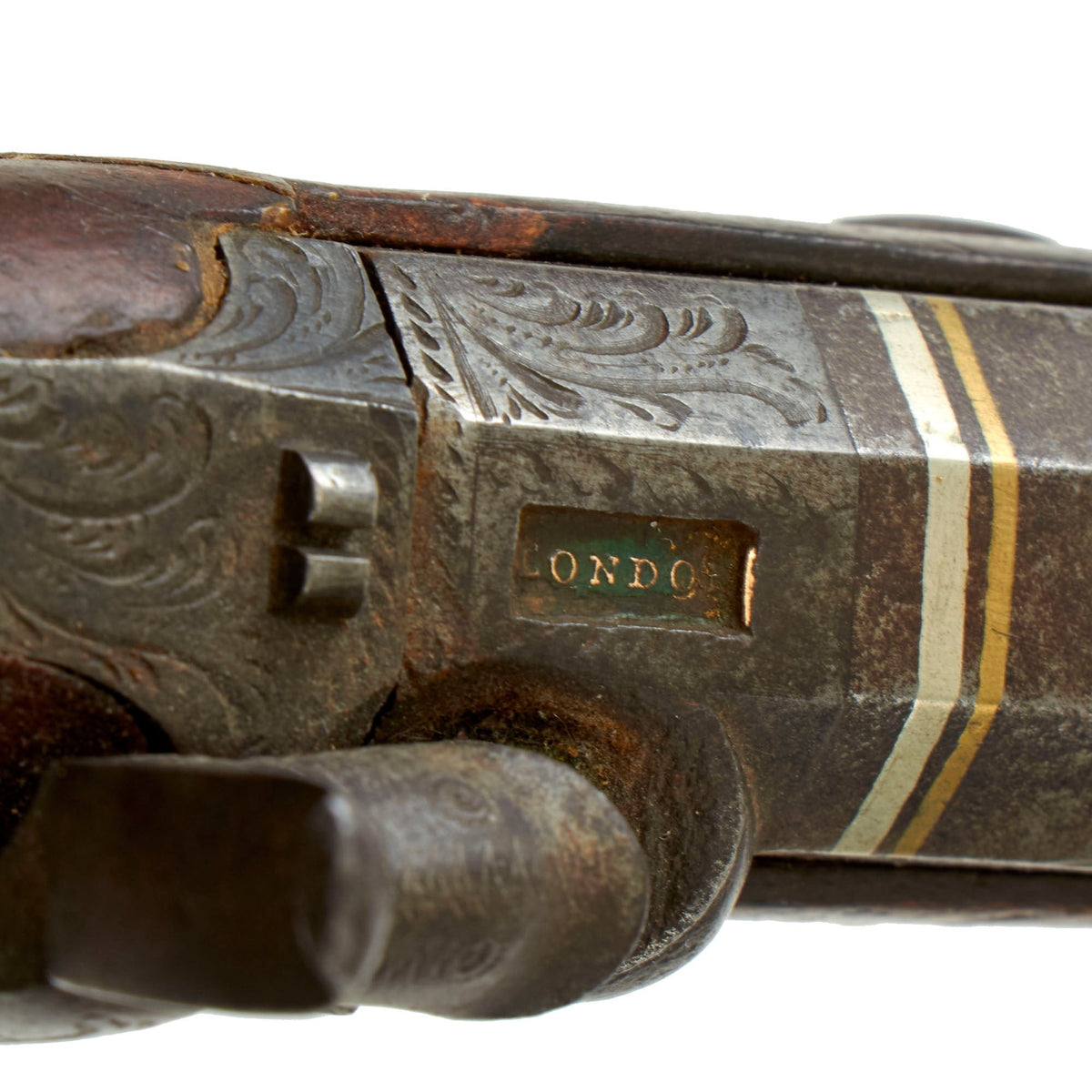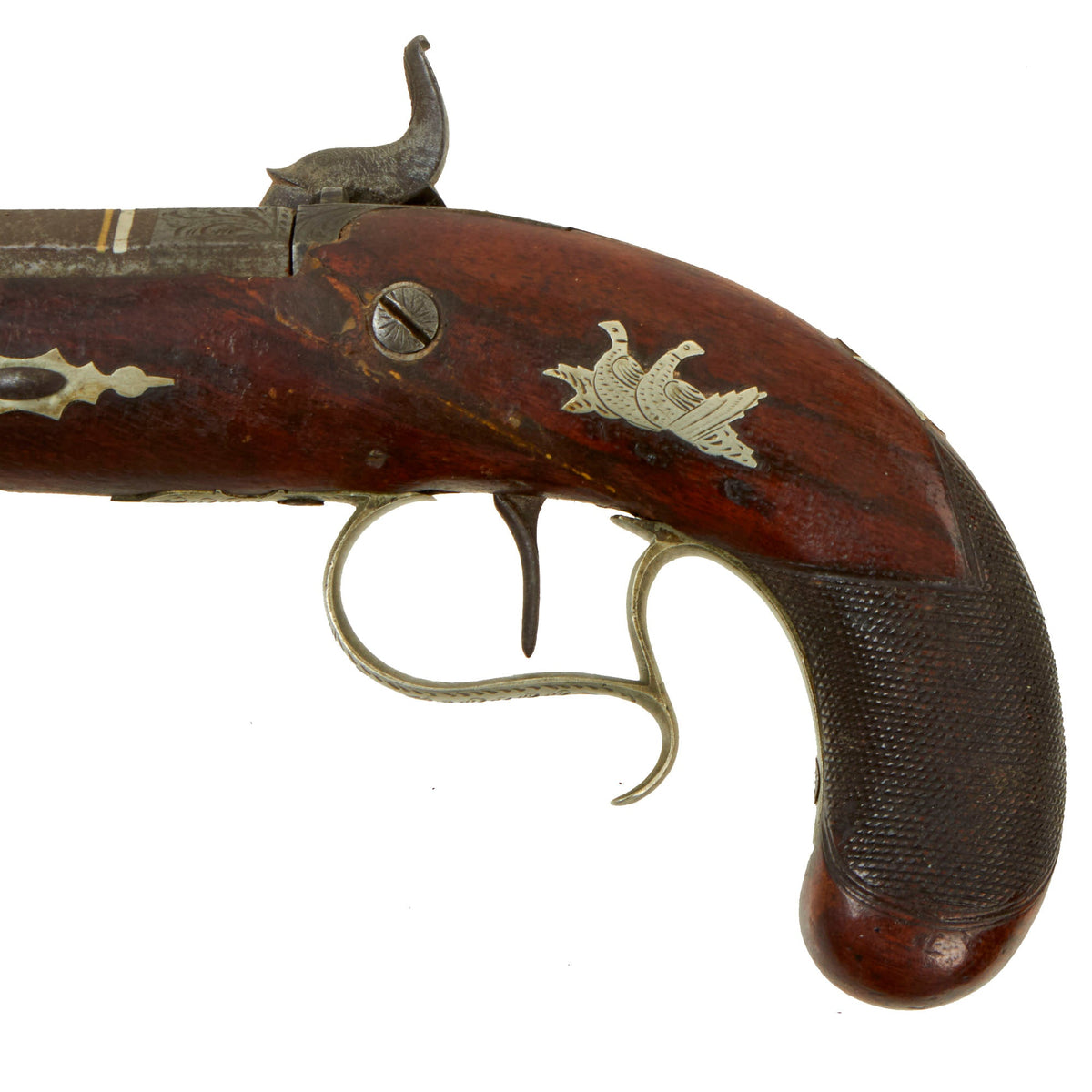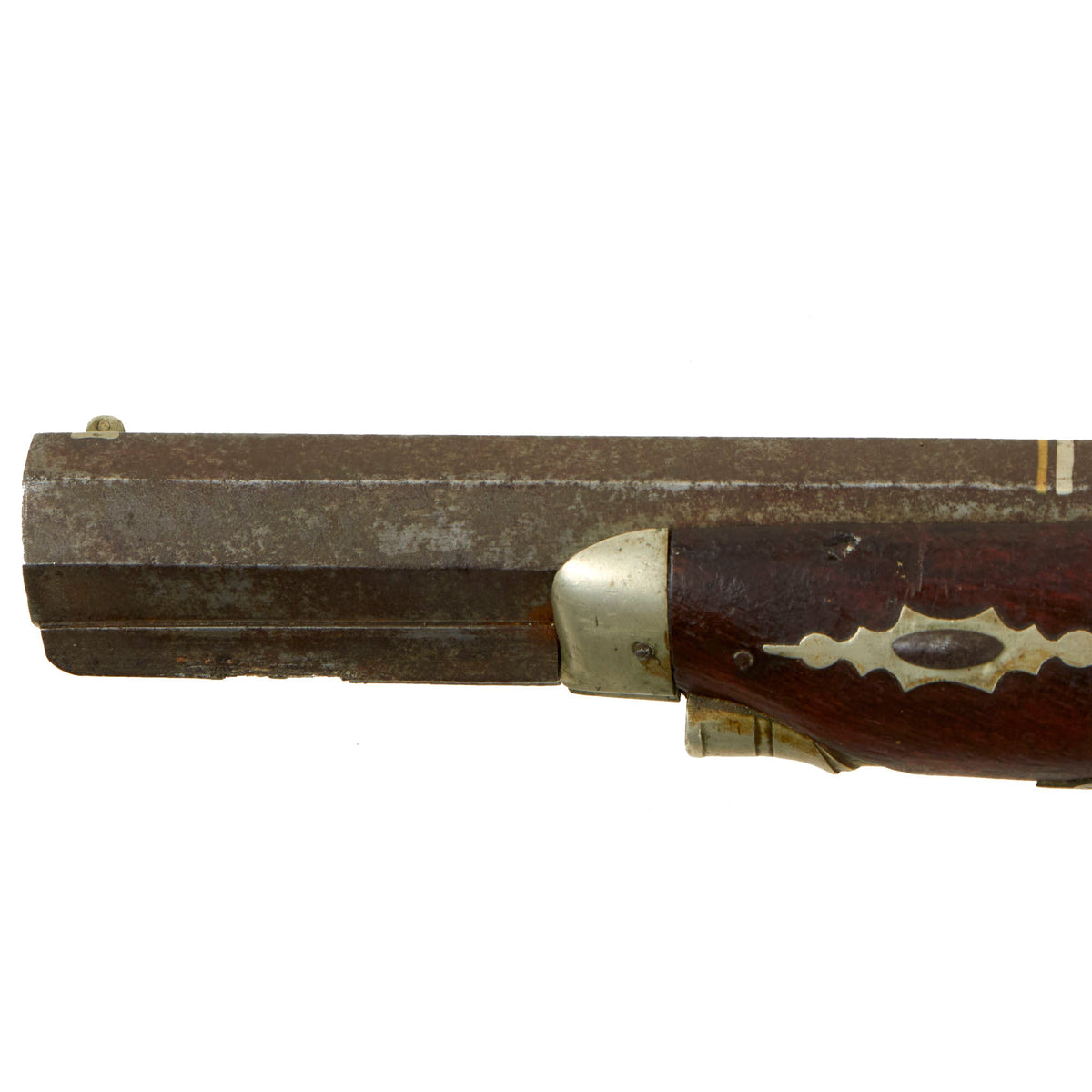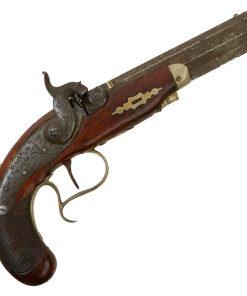Original British Nickel Silver Mounted “Philadelphia Deringer” Style Pocket Percussion Pistol by Richard Hollis – Circa 1845 Original Items
$ 695,00 $ 208,50
Original Item: Only One Available. It was a small percussion concealable pistol made by “DERINGER” that John Wilkes Boothe used to assassinate President Abraham Lincoln at Ford’s Theater in 1865. By this action alone the name Deringer entered national mind and language of the United States being linked to “an Assassin’s weapon”. Now spelled with two consecutive “R”s, the term DERRINGER is part of everyday life.
So famous did Henry Deringer become that almost every Gun Maker in Philadelphia start copying his product, despite the fact that he made supposedly up to 15,000 units over his lifetime. This style also was too popular to stay confined to the United States, and during the Pre-Civil War Era examples of the style were made by British gunsmiths as well, possibly for export to the American market.
This is one of the British examples, signed on the lock Rich’d Hollis, for well-known London gunmaker RICHARD W. HOLLIS, who worked from 1790 until 1850. We have had several percussion fowling pieces from this maker, and they all have been very nice. This is the first example we have had of a pistol by this maker, and we estimate it was made circa 1845, towards the end of his career.
It measures 9 1/2″ in overall length with a 5″octagonal .50″ bore barrel with heavy 8 groove rifling. The top of the barrel is marked LONDON on the engraved breech plug, and there are brass and nickel silver inlays in front of this. This is definitely one of the larger “Deringer” style models we have seen, but still very concealable. These were the ideal assassin’s pistol of the Civil War era. The pistol is fully nickel silver mounted, with some great engraving on the trigger guard, and two game birds inlaid on the left side of the stock. It was originally fitted with a ramrod, however this is missing, and the pipe on the bottom of the barrel is missing as well. There is also an escutcheon on the back of the grip.
Pulling out the barrel wedge allowed us to remove the barrel, and the bottom is marked RH, probably for Richard Hollis, along with a serial number 10309. It also is marked with the CROWN / CROSSED SCEPTERS / BPC “proof” and CROWN / CROSSED SCEPTERS / V “viewed” marks from the English city of Birmingham. These are the correct markings for pre-1853 manufacture.
Condition is very good, though it definitely suffered damage to the stock long ago, which looks to have split through along the grain, running from the trigger guard up to the breech area. This was repaired long ago, but could possibly be improved upon. The lock is functional, but it does not hold at half cock, and is very sensitive in the fully cocked position.
A lovely little pistol with heaps of character, just waiting to be in someone’s British or Civil War Collection. Ready to display!
Specifications:
Year of Manufacture: circa 1845
Caliber: about .50 inches
Ammunition Type: Lead Ball & Powder with Percussion Cap
Barrel Length: 5 inches
Overall Length: 9 1/2 inches
Action: Back Action Percussion Lock
Feed System: Muzzle-Loaded
History of the “Philadelphia Deringer”
The Philadelphia Deringer was a small percussion handgun designed by Henry Deringer (1786–1868) and produced from 1852 through 1868. A popular concealed carry handgun of the era, this pocket pistol design was widely copied by competitors, sometimes down to the markings.
For loading a Philadelphia Deringer, one would typically fire a couple of percussion caps on the handgun, to dry out any residual moisture contained in the tube or at the base of the barrel, to prevent a subsequent misfire. One would then remove the remains of the last fired percussion cap and place the handgun on its half-cock notch, pour 15 to 25 grains (1 to 2 g) of black powder down the barrel, followed by ramming a patched lead ball down onto the powder, being very careful to leave no air gap between the patched ball and the powder, to prevent the handgun from exploding when used. (The purpose of the patch on the ball was to keep the ball firmly lodged against the powder, to avoid creating what was called a “short start” when the ball was dislodged from being firmly against the powder.)
A new percussion cap would then be placed on the tube (what today would be called a nipple), and the gun was then loaded and ready to fire. (The half-cock notch prevented the hammer from falling if the trigger were bumped accidentally while carrying the handgun in one’s coat pocket.) Then, to fire the handgun, a user would fully cock the hammer, aim, and squeeze the trigger. Upon a misfire, the user could fully re-cock the hammer, and attempt to fire the handgun once more, or, equally common, switch to a second Deringer. Accuracy was highly variable; although front sights were common, rear sights were less common, and some Philadelphia Deringers had no sights at all, being intended for point and shoot use instead of aim and shoot, across Poker-table distances. Professional gamblers, and others who carried regularly, often would fire and reload daily, to decrease the chance of a misfire upon needing to use a Philadelphia Deringer.
Henry Deringer’s production records, and contemporaneous records of his imitators, indicate that these pistols were almost always sold in matching pairs. (A typical price was $15 to $25 for a pair, with silver-inlaid and engraved models selling at higher prices.) The choice of buying a pair, in part, was to compensate for the limited power of a single-shot, short-barreled pistol, and to compensate for a design considerably less reliable than subsequent cartridge derringer designs. Original Deringers are almost never found still in their matched pairs today.
Initially popular with military officers, the Deringer became widely popular among civilians who wished to own a small and easily concealable pistol for self-defense.
In total, approximately 15,000 Deringer pistols were manufactured. All were single barrel pistols with back action percussion locks, typically .41″ rifled bores, and walnut stocks. Barrel length varied from 1.5″ to 6″, and the hardware was commonly a copper-nickel alloy known as “German silver”. The back action lock was a later, improved design among locks, which had its spring and mechanism located behind the hammer, where it was thereby protected from dirt, fired cap residue, and gunpowder residue unlike earlier front action locks that had their springs and mechanism located directly in the path of such residue in front of the hammer, under the tube.
Because of their small size and easy availability, Deringers sometimes had the dubious reputation of being a favored tool of assassins. The most famous Deringer used for this purpose was fired by John Wilkes Booth in the assassination of Abraham Lincoln. Booth’s Deringer was unusual in that the rifling twisted counterclockwise (left-handed twist), rather than the typical clockwise twist used on most Philadelphia Deringers.
NOTE: International orders of antique firearms MUST be shipped using UPS WW Services (courier). USPS Priority Mail international will not accept these. International customers should always consult their country’s antique gun laws prior to ordering.
Fast Shipping with Professional Packaging
Thanks to our longstanding association with UPS FedEx DHL, and other major international carriers, we are able to provide a range of shipping options. Our warehouse staff is expertly trained and will wrap your products according to our exact and precise specifications. Prior to shipping, your goods will be thoroughly examined and securely secured. We ship to thousands clients each day across multiple countries. This shows how we're dedicated to be the largest retailer on the internet. Warehouses and distribution centres can be located throughout Europe as well as the USA.
Note: Orders with more than one item will be assigned a processing date depending on the item.
Before shipping before shipping, we'll conduct a thorough inspection of the items you have ordered. Today, the majority of orders will be delivered within 48 hours. The delivery time will be between 3-7 days.
Returns
The stock is dynamic and we cannot completely manage it because multiple stakeholders are involved, including our factory and warehouse. So the actual stock may alter at any time. It's possible that you may not receive your order once the order has been made.
Our policy is valid for a period of 30 days. If you don't receive the product within 30 days, we are not able to issue a refund or an exchange.
You can only return an item if it is unused and in the same state as the day you received it. You must have the item in its original packaging.
Related products
Uncategorized
Band of Brothers ORIGINAL GERMAN WWII Le. F.H. 18 10.5cm ARTILLERY PIECE Original Items
Uncategorized
Uncategorized
Uncategorized
Uncategorized
Uncategorized
Uncategorized
Uncategorized
Australian WWII Owen MK1 Machine Carbine SMG Custom Fabricated Replica with Sling Original Items
Uncategorized
Uncategorized
Uncategorized
Uncategorized
Uncategorized
Uncategorized
Armoured Fighting Vehicles of the World: AFVs of World War One (Hardcover Book) New Made Items
Uncategorized
Uncategorized
Angolan Rebel 1970s era 60mm Inert Display Mortar from Angolan Civil War Original Items
Uncategorized
Uncategorized
Armored Burgonet Helmet & Polearm from Scottish Castle Leith Hall Circa 1700 Original Items
